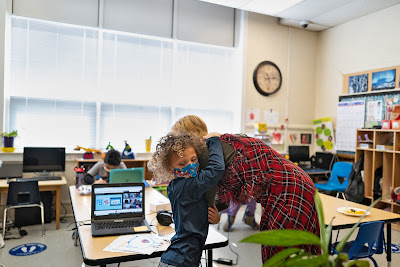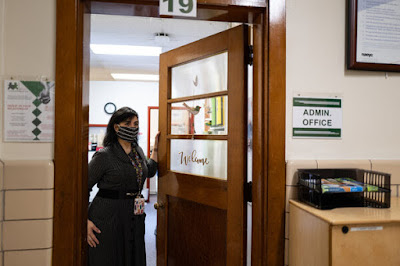New York Times features ACCA Child Development Center in piece on childcare challenges during the pandemic
 |
| ACCA Child Development Center Executive Director Maria-Isabel Ballivian speaks at the White House. At the left is Vice President Kamala Harris. [Doug Mills/The New York Times] |
A recent article in the New York Times on how childcare leaders are struggling to manage during the COVID pandemic includes a first-person account from Maria-Isabel Ballivian, executive director of the ACCA Child Development Center on Columbia Pike in Annandale.
The article, titled “Child Care in Crisis: Can Biden’s Plan Save It?” is part of the “In Her Words” series. It features childcare leaders in Rocky River, Ohio; Midland, Mich.; and Vista, Calif.; as well as Annandale.
After the article was published, Ballivian was invited to give a speech at a White House event where Vice President Kamala Harris announced the release of $39 billion from the American Rescue Plan to address the child care crisis.
“I stand here today on behalf of thousands of childcare providers and educators who have decided to maintain their programs and keep fighting for young children and parents,” Ballivian said in her speech.
“We as a country must come together and bring our best to ensure that every child grows knowing that they are worth the time, the effort, and the investment,” she said. “They deserve nothing less.”
 |
| A young child at the ACCA Child Development Center. [Cheriss May for The New York Times] |
What follows is the section on Ballivian in the New York Times article, which was published March 31 and updated April 11.
In April [2020], Maria-Isabel Ballivian got a call from a man in Annandale, Va., whose wife had tested positive for Covid-19. She was displaying severe symptoms, he said, leaving him to care for their three children, all younger than 5. They lived in the basement of a house, making social distancing difficult.
“He was by himself, without any food or any understanding of what to do,” Ms. Ballivian, 47, said. She arranged to get some groceries and cleaning supplies delivered to the family and contacted the health department to get him and the children tested and isolated.
This interaction – though not a formal part of Ms. Ballivian’s job description as executive director of the ACCA Child Development Center – has become part of a new normal for her. ACCA, a nonprofit organization that opened in 1967, serves many of Annandale’s working-class, immigrant families. About 90 percent of the children enrolled in ACCA – all aged zero to five – are eligible for government subsidies and, for a large majority, English is their second language.
 |
| Jaylen, 5, hugs his grandmother at the ACCA Child Development Center. [Cheriss May for The New York Times] |
When the pandemic hit, ACCA suddenly became the nucleus of the community – a place to get information, fresh food, or even a space for school-age children to log on for virtual classes.
Through May, Ms. Ballivian partnered with the health department to create care packages with basic supplies – face masks, hand sanitizer, cleaning equipment, and information packets about the virus – and distributed them to all the families that were enrolled at the center. And she instructed her older and immunocompromised staff members – whom she had sent home to work remotely – to set up a time for daily virtual check-ins with families on their roster.
“Because we serve a lot of low-income families, the incidence of children exposed to abuse and neglect is higher,” Ms. Ballivian said. “So, that group that we set up to work with the families remotely had the task of doing two things: checking on the children and checking on the adults to make sure that everybody was OK.”
“Sometimes they would answer the phone and engage with us and sometimes they wouldn’t, so we would just try again the next day,” she added.
Many of the parents who use ACCA are frontline workers with few childcare options, so ACCA had to stay open.
To make this happen, many of Ms. Ballivian’s staffers brought their school-age children to the center so they could log on for virtual school while their parents worked their shifts.
Then, parents started dropping off the older siblings of some of the toddlers already enrolled in the program. Before she knew it, Ms. Ballivian had 54 school-age children at the center, up from zero before the pandemic.
Food turned out to be a challenge. Normally, the center would get its children’s lunches from the county’s school district. But when schools closed, so did their kitchens. Ms. Ballivian’s team was left trying to figure out how to bridge the gap.
Luckily, Ms. Ballivian already had a food handler’s license, and some of her staffers were trained to prepare food. So “we just went to Best Buy and brokered a deal with them and got some grills and air fryers,” she said. They improvised lunch each day, throwing chicken nuggets into the fryer or grilling some vegetables.
“Little did we know at that time that this situation was going to stand until now,” she added. “We now have a full meal service program with a brand-new commercial dishwasher.”
 |
| Maria-Isabel Ballivian at the ACCA Child Development Center. [Cheriss May for The New York Times] |
In May, she managed to secure a loan of about $500,000 under the Paycheck Protection Program included in the first rescue package Congress passed last March, which carried the center through for a few months.
And Virginia, like a few other states, waived its longstanding policy that government subsidies for children would be paid out based on attendance, instead paying childcare centers based on enrollment. Since so many of Ms. Ballivian’s children qualified for government subsidies, that policy provided much-needed relief, she said.
But that policy expired on July 1.
And when in August, the schools didn’t open back up, “the children who were supposed to graduate and go into the school system never did; they stayed with us,” Ms. Ballivian said. “These children are registered in the school system getting virtual education, and what we’re doing here is facilitating that virtual education.”
Enrollment at ACCA didn’t dip much, because the center served essential workers, but the costs of more desks and air filters, not to mention the kitchen equipment, kept adding up. When Covid cases cropped up, parts of the school would have to close for two weeks, resulting in $30,000 of lost revenue each time. By September, the center was starting to lose money.
“I have to be honest with you: At times, I thought, is this worth it? Is this fight worth it?” Ms. Ballivian said. “But there was one day when I saw a child, who had been diagnosed with special needs, sitting in a classroom and playing with a set of bells. I thought to myself, even if it were just for this one child, even if the only person that we’re impacting positively is this one child, then it’s worth it.”


It is so worth it. Thank you ACCA.
Looks great. Happy to see a local group get national attention. Unfortunately, I can't read the NYT article because I don't have or want a NYT account.